
Crucial BX300 SSD Review: Micron Brings Affordable MLC SSDs To The Market
Introduction

In June 2016, Micron introduced the Crucial MX300 which was well-received by the enthusiast community for being highly affordable while still offering top-notch performance. About a month ago Crucial announced the BX300 series SSDs which are designed for value-oriented users who are into building and upgrading their own computers.
Crucial's BX300 series range in capacities of 120GB, 240GB and 480GB, and are only available in a 2.5" form factor. The BX300 SSDs are available for purchase at $60 for the 120GB model, $90 for the 240GB model, and $145 for the 480GB version and come with a three-year limited warranty. The previous generations of the BX series had much larger capacities so hopefully Crucial will release a 1 TB option in the future but for now 480GB is the max capacity you can buy.
Crucial advertises the BX300 series with sequential read speeds of up to 555 MB/s and sequential write speeds of up to 510 MB/s for all capacities. When it comes to random 4K write speeds, all capacities are rated for up to 90K IOPS but random 4K read speeds vary by capacity. So random 4K read speeds for the 120GB model is rated for up to 45K IOPS, for the 240GB model up to 84K IOPS, and for the 480GB version up to 95K IOPS.
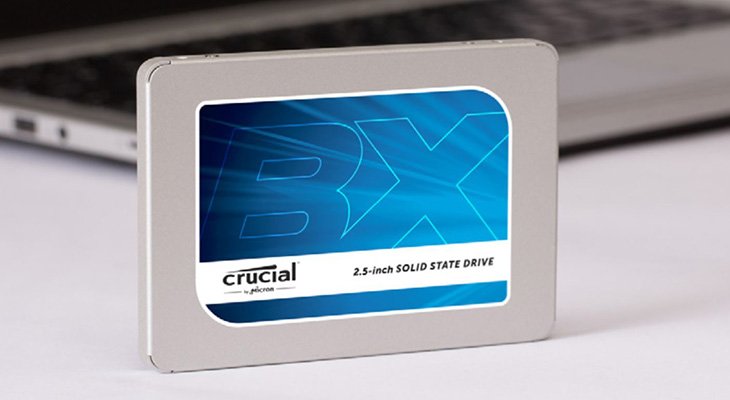
The BX300 SSDs use Micron's first-generation 3D MLC NAND and the Silicon Motion SM2258 four-channel controller backed by Micron's low-power DDR3 memory. Keep in mind that the BX series are geared toward budget users and using MLC NAND on entry level SSDs is expensive even for a company as big as Micron. Entry level SSDs typically utilize TLC NAND because it is cheaper but Micron is selling MLC SSDs for cheaper than their TLC SSDs in a period where there is an industry-wide NAND shortage.
The four most important components of an SSD are the NAND flash memory, the controller, the DRAM and the firmware. With that being said, there are four types of NAND flash technologies. The first one is SLC which is 1 bit per cell and is the fastest and the most expensive NAND to produce. Then we have MLC which is 2 bits per cell and is also quite expensive to produce. And then we have TLC which is 3 bits per cell and is the most used NAND in entry level SSDs because it’s much cheaper than MLC and SLC to produce. And the last one is QLC which is 4 bits per cell and is the slowest and the cheapest NAND to produce.
Pricing & Endurance
Crucial's 3D-NAND technology is built to endure 55TB (TBW) which equals to about 30GB per day for 5 years for the 120GB model. The 240GB model on the other hand can handle up to 80TB written (TBW) and the 480GB model for up to 160TB (TBW). The BX300 240GB's endurance equates to approximately 44GB daily read/write workload over a 5-year period while the 480GB model equates to approximately 88GB daily for 5 years.
Crucial's BX300 main competitor is the Samsung 850 Evo but keep in mind that the BX300 uses MLC while the 850 Evo uses TLC NAND so it will be interesting to see which one is the fastest when we benchmark these two SSDs. Samsung released the 850 Evo and 850 Pro about three years ago and it was the first manufacturer to release SSDs with 3D Vertical NAND. The 850 Pro still remains the fastest consumer SATA SSD on the market while the 850 Evo on the other hand is the most popular SSD for most consumers and offers very good performance too.
Price-wise, the 850 Evo SSDs are significantly more expensive than the BX300 drives. For example, the 850 Evo 120GB retails for $100 while the BX300 120GB sells for $60 which makes the BX300 120GB about $40 cheaper. The other BX300 models are just as cheaper but capacity-wise, the BX300 series max out at 480GB while Samsung offers users up to 4TB which is very impressive.
Not only does Crucial have the upper hand in price but also in write endurance too. Crucial's BX300 SSDs offer higher write endurance than the 850 Evo SSDs. Samsung's 850 Evo 250GB drive can only endure 75TB (TBW) while the BX300 240GB endures up to 80TB TBW. The BX300 480GB comes with 160TB (TBW) which is about 10TB more than the 850 Evo 500GB that supports up to 150TB (TBW). The difference in write endurance between the 850 Evo and BX300 is not very big but it's worth mentioning it.
Features
The BX300 supports many advance features such as Thermal Monitoring technology which dynamically adjusts storage component activity to help keep your system cool and minimizes the risk of damage caused by overheating. It also supports Self Monitoring and Reporting Technology (SMART) which basically is a monitoring system used to perform an analysis of the drive for problems with the intent of anticipating hardware failures.
Crucial's BX300 comes with support for error correction codes (ECC) which is used in NAND Flash memories to detect and correct bit-errors. The BX300 also supports TRIM which basically means the operating system can inform the SSD which blocks of data are no longer in use and can be wiped internally.
The BX300 utilizes SLC Write Cache to boost write performance which is a fixed SLC cache size that comes out to 4GB for the 120GB model, 8GB for the 240GB model and 16GB for the 480GB version. SLC Write Cache is designed to dramatically speed up write performance of SSDs based on MLC and TLC NAND flash memory by writing a single bit to each flash cell.
The Silicon Motion SM2258 controller supports Opal/TCG encryption which can be used to keep your personal files and confidential data restricted from hackers and thieves with AES 256-bit encryption but Crucial has chosen to disable this feature on the BX300.
These are all the advanced features the BX300 supports:
- Multistep Data Integrity Algorithm
- Thermal Monitoring
- SLC Write Acceleration
- Active Garbage Collection
- TRIM Support
- Self Monitoring and Reporting Technology (SMART)
- Error Correction Code (ECC)
- Device Sleep Extreme Low Power Mode (DEVSLP)
Specifications
| Crucial BX300 Series Lineup | |||
|---|---|---|---|
| Model: | BX300 120GB | BX300 240GB | BX300 480GB | Price: | $59.99 | $89.99 | $144.99 |
| Interface: | SATA III 6Gb/s | ||
| Form Factor: | 2.5" | ||
| Flash Technology: | 3D Vertical | ||
| Controller: | SMI SM2258 | ||
| DRAM: | 256MB DDR3 | 512MB DDR3 | |
| NAND: | Micron 256Gbit 32-layer 3D MLC 16nm (Gen 1) | ||
| Sequential Read: | 555 MB/s | ||
| Sequential Write: | 510 MB/s | ||
| Random Read: | 45K IOPS | 84K IOPS | 95K IOPS |
| Random Write: | 90K IOPS | ||
| Endurance: | 55 TB TBW | 80 TB TBW | 160 TB TBW |
| Operating Temperature: | 0°C to 70°C | ||
| MTBF: | 1.5 Million Hours | ||
| SLC Write Cache: | 4GB | 8GB | 16GB |
| Firmware: | M2CR010 | ||
| TRIM supported: | Yes | ||
| Encryption: | None | ||
| Warranty: | 3 Years | ||
| Launch Date: | August 2017 | ||
Packaging
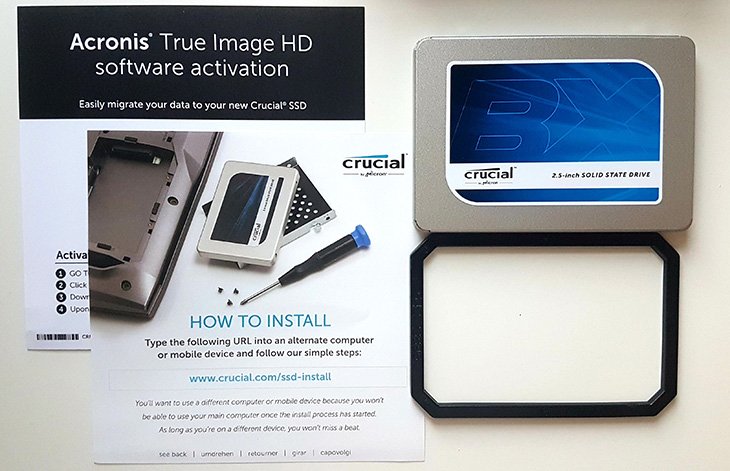
The Crucial BX300 SSD comes in a silver aluminum enclosure and features the standard SATA III interface. Crucial includes Acronis True Image HD software for transferring data from your old drive to your new BX300 SSD and they also include a 7mm to 9.5mm drive spacer to help fit the SSD in notebooks. Like most SSDs, the Crucial BX300 utilizes the SATA III 6Gbps interface but it is compatible with SATA II and SATA I interfaces, but that means it will work at a reduced speed.
You can download the Crucial Storage Executive software which helps monitor and enhance the performance of your SSD and it also allows you to update the firmware, monitor, and secure-erase the SSD. When you are inside the Storage Executive software, make sure to enable the Momentum Cache feature to instantly improve burst performance. Momentum Cache is not restricted by SATA bus throughput limitations but instead it uses additional DRAM bandwidth to achieve increased burst performance. You can also monitor your SSD’s temperature and health, and track how much storage you’ve used.
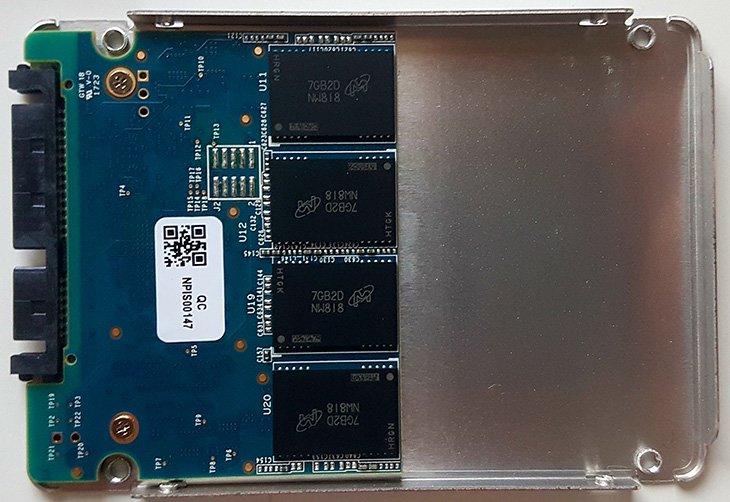
Once the SSD is opened, you will immediately notice how small the PCB is. On each side of the PCB you will find four NAND flash memory ICs which are produced by Micron and are built on a 16nm 3D NAND process. On the other side you will find the Silicon Motion SM2258 4-channel controller and a DRAM chip next to it which basically provides the SSD controller with RAM. The 120GB and 240GB models get 256MB DRAM cache buffer while the 480GB model has a 512MB DRAM cache buffer.
Test Methodology
| Test Setup | |
|---|---|
| Processor: | AMD Ryzen 7 1700X (3.8Ghz) |
| Motherboard: | MSI X370 xPower Titanium (BIOS v1.9) |
| RAM: | Ballistix Elite 16GB (2x8GB) DDR4 3200 MHz |
| Graphics Card: | Nvidia GeForce GTX 1070 |
| Storage: | Crucial BX300 240GB Crucial BX300 480GB Crucial MX300 525GB Crucial MX300 1050GB Samsung 850 EVO 500GB Samsung 850 EVO 250GB Samsung 850 Pro 512GB |
| Power Supply: | SilverStone ST80F-TI (800W) |
| Heatsink: | Noctua NH-D15 |
| OS: | Windows 10 Home 64-Bit |
| Thermal Compound: | Noctua NT-H1 |
| Case: | Corsair 400C |
To make sure these drives perform at their maximum performance, we will be disabling all the power saving features in the BIOS (C6-state, etc). The testing was done on a fresh install of Windows 10 64-bit with the latest windows updates installed. We disabled a bunch of unnecessary services and removed all the bloatware from Windows 10 to make sure there were as few processes running as possible during the testing.
We'll be using the AMD Ryzen 7 1700X processor overclocked to 3.8Ghz and the MSI X370 xPower Titanium motherboard
with the latest BIOS version which at the time of writing this is v1.90.
Installing and using an SSD is pretty straight forward, simply connect one end of your SATA cable to the SATA port in your motherboard and the other end of the cable to your SSD.
After installing windows, make sure to check if you have the latest firmware.
Benchmark Software:
+ Windows 10 Startup
+ Adobe PS CS6 Startup
+ AS SSD
+ IOMeter
+ HD Tune Pro
+ ISO File Copy
Benchmark Results
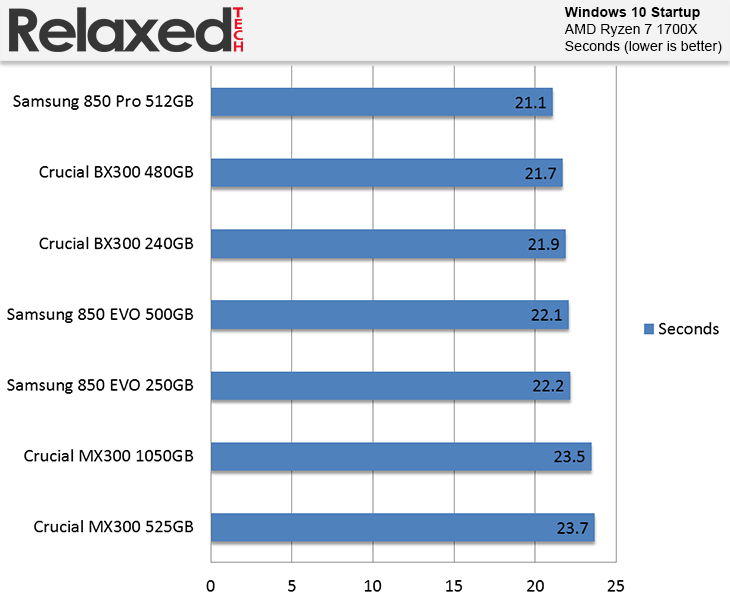
Windows 10 boot times are measured from the time it takes between hitting the power button to reaching the Windows desktop.
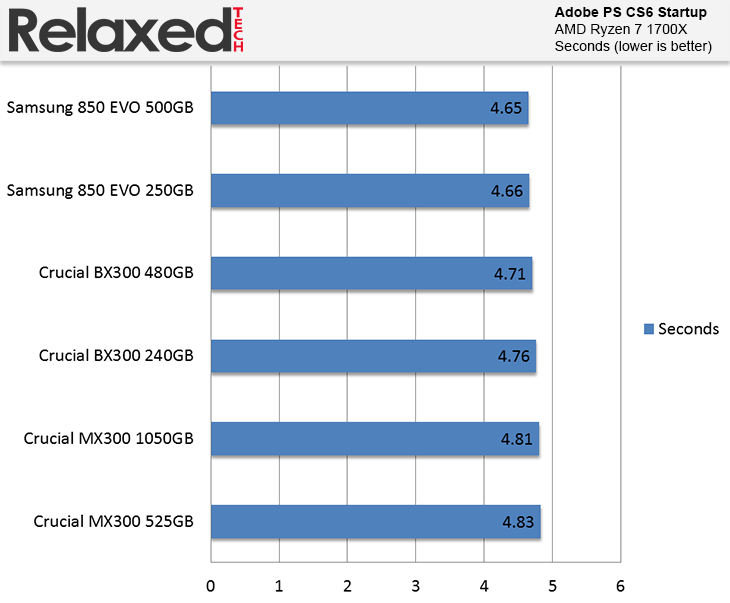
Startup times for Adobe Photoshop CS6 are measured from the moment it takes to open up the application.
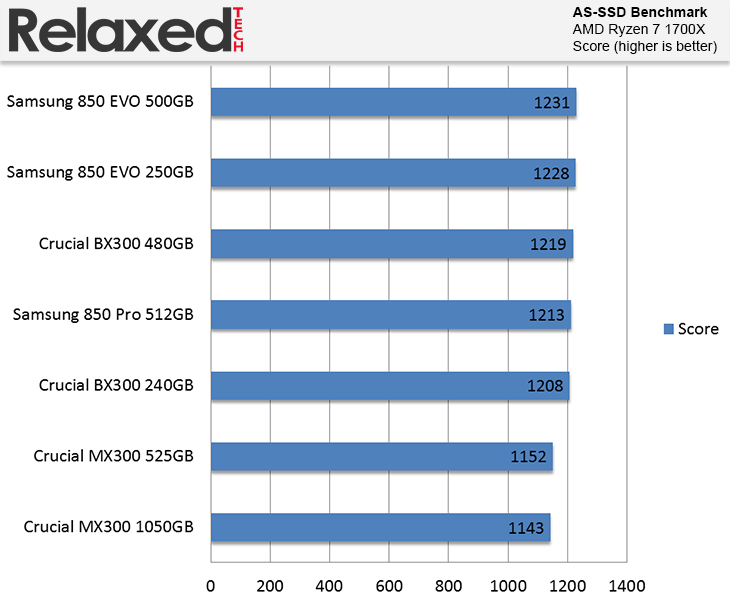
The AS-SSD software is a popular benchmarking software used to measure the performance of an SSD. In this test we are measuring the overall score.
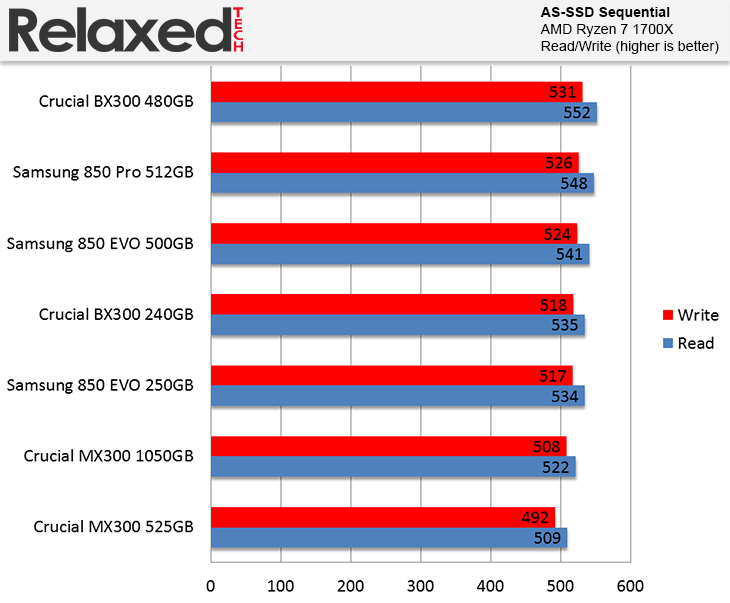
Once again, we are using the AS-SSD software to measure sequential read and write speed of each drive.
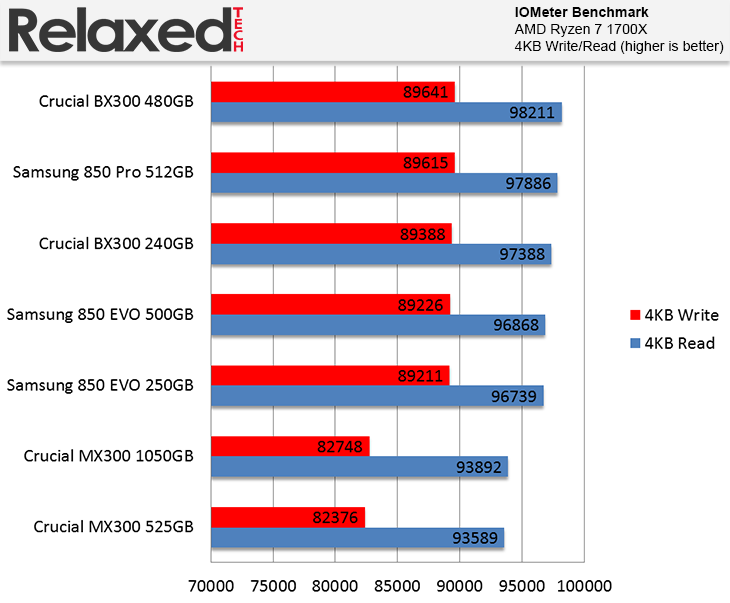
In this test, we are using IOMeter which is one of the best application for stress testing the random IO performance of an SSD. IOMeter is set to use 4KB file size chunks and will stress the SSD with random 4 KB files.
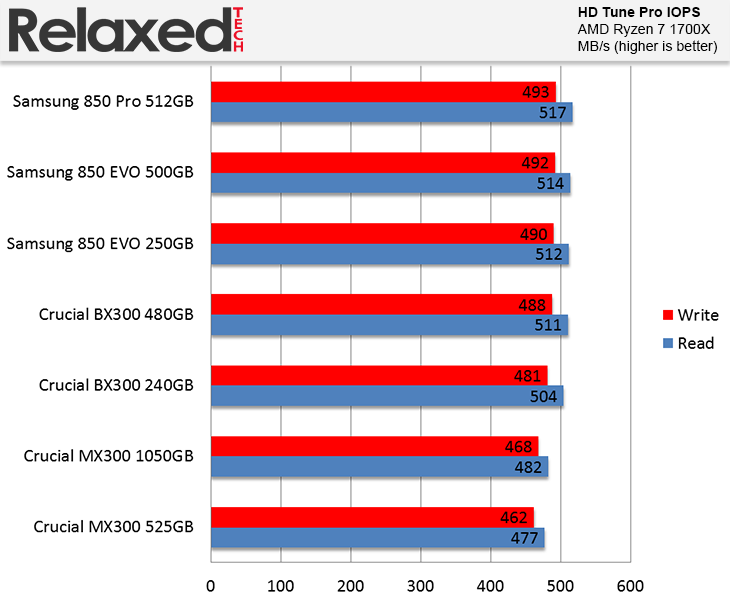
Here we are using HD Tune Pro to measure read and write IOPS. HD Tune Pro is a Hard Disk Utility with many functions such as error checking, S.M.A.R.T and benchmarking.
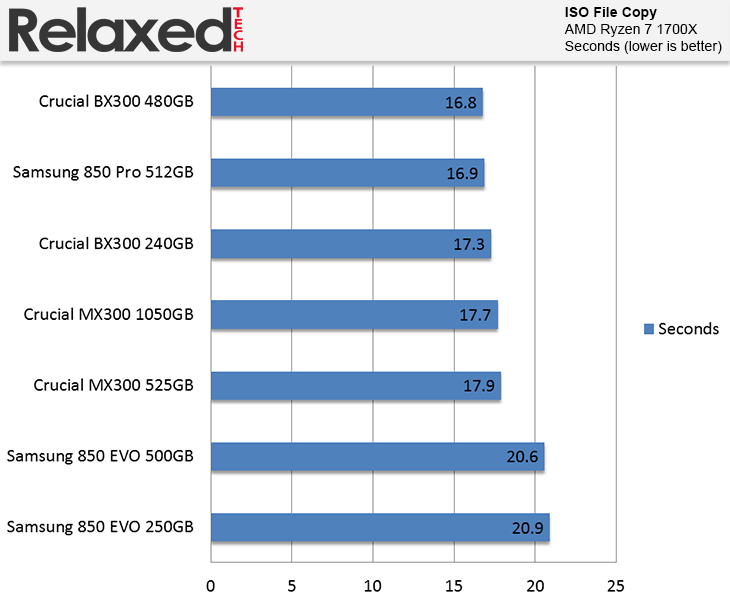
To represent a large file usage scenario, we are copying a 5GB ISO image to a different folder on the same drive.
Conclusion
Crucial has a winner on their hands with the BX300 SSDs. The 240GB and 480GB models we tested offer excellent performance and compare very well with the 850 EVO and 850 PRO. Price-wise, the BX300 SSDs are hard to beat and offer more performance per dollar compared against the Samsung SSDs. If you are using a traditional hard drive, definitely consider upgrading to an SSD like the BX300 because it will offer a massive upgrade in every aspect from read/write speeds to access times.
Pros:
+ Outstanding Performance
+ Includes 7mm to 9.5mm Spacer
+ Affordable
+ Uses MLC NAND
+ Great Firmware
Cons:
- Three Years Warranty
- Only 480GB Max Capacity Available
- Not Available In Other Form Factors
The only downside that I see with the BX300 SSDs is the short three year warranty.
Samsung provides a 5-year warranty for their 850 EVO SSDs and 10-years for their 850 Pro SSDs.
Also, I hope that Crucial releases a 1TB model in the future and makes the BX300 available in other form factors.
Other than that, the BX300 480GB and 240GB SSDs are easily one of the best SSDs that I have ever tested.
Crucial ships their BX300 SSDs with Acronis True Image that can be used to provide data protection including, backup, archive, access and recovery. If you're looking to buy a strong and reliable SSD, the new Crucial BX300 SSDs are speedy and quite affordable. Overall, I believe the Crucial BX300 240GB and 480GB SSDs deserve our Elite award.
Final Score 9.5
